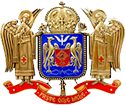

|
The Romanian Orthodox Church is a Church of apostolic origins, born out of the mission of St Andrew the Apostle, who preached the Word of the Gospel also in the old Roman province of Scythia Minor, the territory between the Danube and the western part of the Black Sea, present Dobrogea (south east of Romania).
On 25 April 1885, the Romanian Orthodox Church became autocephal (self-governing) and on 25 February 1925 she was elevated to the rank of Patriarchate, being in dogmatic, liturgical and canonical communion with the other Sister Orthodox Churches.
According the last census, (2002), Romania has a population of 21,794,793 inhabitants, of which 86,7 % declared themselves as Christian Orthodox.
1. Organisation
The Romanian Orthodox Church is organised as Patriarchate and comprises:
|
|
|
A) Central Organisation
The Holy Synod is the highest authority of the Romanian Orthodox Church in all her matters of activity. The Holy Synod is made up of the Patriarch, as president, and all metropolitans, archbishops, bishops, assistant bishops to the Patriarch and assistant bishops in function.
The deliberative central body of the Romanian Orthodox Church for all administrative, social, cultural, economical and patrimonial issues is the National Church Assembly, made up of three representatives of each diocese or archdiocese (a clergy and two lay persons), appointed by the respective diocesan assemblies for a term of four years. The members of the Holy Synod participate in it with deliberative vote.
The central executive body, both of the Holy Synod and of the National Church Assembly, is the National Church Council, made up of twelve members of the National Church Assembly (one clergy and one lay person representing each metropolitanate from Romania, designated for a term of four years). The members of the Holy Synod may participate in it with deliberative vote.
The Primate of the Romanian Orthodox Church is His Beatitude Patriarch DANIEL, elected on 12 September 2007 and enthroned as the 6th Patriarch of Romania on 30 September 2007.
|
His Beatitude Patriarch DANIEL
|
|
B) Local Organisation
The administrative units of the Romanian Orthodox Church are:
|
|
|
2. Monastic Life
The Romanian Orthodox Church has 637 monasteries and sketes with more than 8,000 monks and nuns.
3. Theological Education
The Romanian Orthodox Church comprises:
|
Sinaia Monastery
|
|
4. Religious Assistance
Besides usual activities in the parishes, religious assistance is also provided in:
5. Social Assistance
Social institutions which are under the patronage of the Romanian Orthodox Church:
|
Retirement Home,
Christiana Monastery, Bucharest
|
|
The Romanian Orthodox Church provides permanent social assistance for around 270.000 persons.
In cases of natural disasters, the Romanian Orthodox Church undertakes humanitarian campaigns at national level, in order to provide immediate assistance to affected persons. At the same time, in partnership with central and local authorities and national and international non-governmental organisations, the Romanian Orthodox Church is involved in national programs for:
|
|
|
6. Church Institutions with missionary purpose
In the Romanian Orthodox Church function:
At the initiative of His Beatitude Patriarch Daniel, on the 27 October 2007, the Romanian Patriarchate’s ”BASILICA Media Centre” was established, being made up of: radio TRINITAS; TRINITAS TV; Ziarul Lumina (The Light Newspaper), Lumina de duminică (The Light of Sunday) and Vestitorul Ortodoxiei (The Orthodox Messenger) publications; BASILICA Press agency and the Press and Communications Office of the Romanian Patriarchate.
|
BASILICA Media Centre,
The Patriarchal Palace
|
|
7. Church and Inter-religious Relations
The Romanian Orthodox Church is member of the World Council of Churches (WCC) beginning with 1961 and of the Conference of European Churches (CEC), from 1964, being also involved in local ecumenical relations. Together with other Orthodox Churches, she participates in international theological dialogues with the Roman Catholic Church, the Protestant Churches, the Anglican Church, etc. The Romanian Orthodox Church takes also part in the wider inter-religious dialogue.
Beginning with 1 January 2007, the Romanian Orthodox Church has, in Brussels, an Office of Representation to the European Union and other European political institutions.
8. Museum Collections for the Conservation of Old Books and Religious Artefacts
In the Romanian Orthodox Church there are 275 museums and museum collections, as well as 42 regional centres for storage.
Contact : |
|